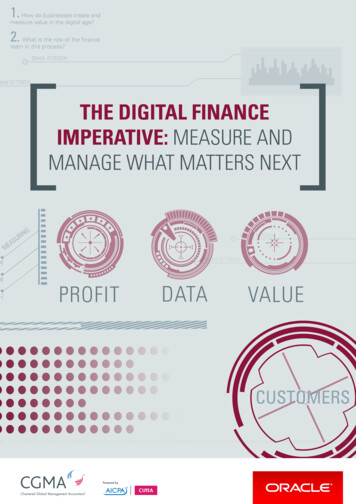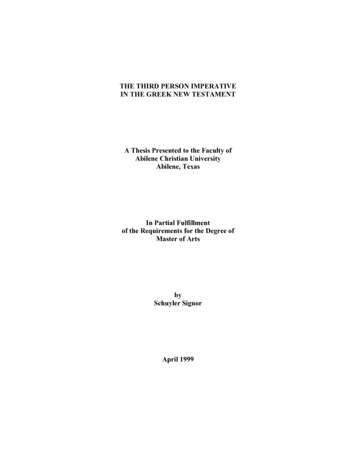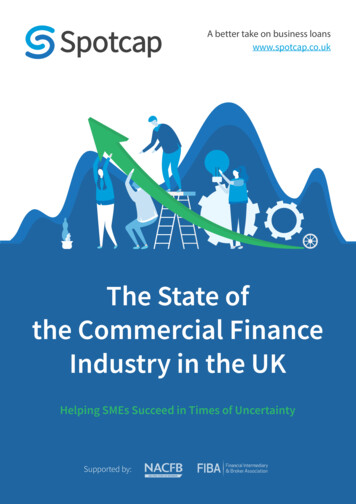
Transcription
1.How do businesses create andmeasure value in the digital age?2.What is the role of the fnanceteam in this process?THE DIGITAL FINANCEIMPERATIVE: MEASURE ANDMANAGE WHAT MATTERS NEXTGINRSUAMEPROFITDATAVALUECUSTOMERSacle sponsored this CIMA research as both organisations seek to answer these two questions. CIMA conducted a global survey of senior finance professionals and other managers across different industries.
CHARTERED GLOBALMANAGEMENTACCOUNTANT (CGMA )Two of the world’s most prestigious accounting bodies, AICPA and CIMA,have collaborated to establish the Chartered Global Management Accountant(CGMA ) designation to elevate and build recognition of the profession ofmanagement accounting. This international designation recognises the mosttalented and committed management accountants with the discipline and skillto drive strong business performance. CGMA designation holders are eitherCPAs with qualifying management accounting experience, or associates orfellow members of the Chartered Institute of Management Accountants.www.cgma.orgORACLEOracle offers a comprehensive and fullyintegrated stack of cloud applications andplatform services. For more information aboutOracle (NYSE:ORCL), visit www.oracle.comored this CIMA research as both organisations seek to answer these two questions. CIMA conducted a global survey of senior finance professionals and other managers across different industries.2
CONTENTSSUAMEGRINExecutive Summary. 41. Context for the Research . 52. What Businesses Need to Know in the Digital Age. 83. Who is Responsible for Performance and Who Providesthe Management Information and KPIs Needed? . 144. The Role of Finance and Its Infuence. 165. Next-Generation Finance . 186. Conclusion and Next Steps. 217. References, Resources and Research Methodology . 243
EXECUTIVE SUMMARYDigitisation and globalisation cause commoditisation and threaten established businessmodels. Intangible assets – such as brands, customer relationships, intellectual propertyand human capital – have become the main value drivers in business. Consequently,business leaders may need to adapt their business models or develop new ones. To achievethis, quality decision-making and value-creating data insights are essential, and are rapidlybecoming determinants of organisational success. Equally, organisations need new measuresto manage performance, develop intangible assets and achieve their strategic goals.CAPTURING VALUABLE DATAIn recent decades, fnanceembraced technology-ledinnovation, automating backoffce processes to boostproductivity, decision-makingand performance management.Today, however, fnance maylag behind marketing, sales andother customer-facing functionsthat are investing widely indigital technologies to capturevaluable data about intangibleassets such as brands, customerrelationships, intellectualproperty and human capital.BRINGING RIGOURTO DECISIONSManagement accounting has thepotential to bring professionalrigour to decision-making byensuring that decisions andperformance management areinformed by proper analysis ofthe relevant information andthat the business is managedin the long-term interests ofits stakeholders.FINANCE MUST MODERNISEThe digital age has redefnedbusiness roles. CFOs and theirfnance teams are being askedto help defne and implementnew, digitally-enabled businessmodels, and must expand theirexisting competencies with indepth knowledge of technologyand analytics, as well as broaderleadership and business partneringskills. Traditional performancemetrics no longer capture thevalue being created by intangibles.CFOs need new metrics tomeasure and monitor these valuedrivers using the latest cloudbased tools and technologies.What is fnance’s role in measuring and monitoring the new value drivers in today’sdigital economy? To fnd the answer, Oracle sponsored comprehensive researchby CIMA and AICPA into the value drivers in the digital age; the new and requiredperformance measures; who provides these measures; and the implications forCFOs and management accountants. Nearly 800 people contributed to this reportthrough a global online survey and interviews. We acknowledge their support andhope the fndings are valuable to them, their employers and you.4
1. CONTEXT FORTHE RESEARCHTHE EXPLODING VALUEOF INTANGIBLE ASSETSImpact on fnance: As corporate structures and businessmodels evolve, so too must the metrics fnance uses tomeasure performance.As the internet era dawned, former GE CEOJack Welch used the term “destroy yourown business” to encourage managers athis company to fnd new internet-enabledways of running their business units.He recognised the risk that new entrants,free from legacy systems, might developnew business models and compete inways that could destroy their company.Fast-forward 30 years, and GE is once again“destroying its own business” by responding to thedigitisation of the industrial sector. The companyis reinventing itself as a software provider for the“Industrial Internet”, using data and analytics tomake planes, trains, automobiles and other machinesworldwide run more effciently.THE POWER OF INTANGIBLE ASSETSGE recognised what many are just learning: that thecompanies creating the most value today aren’t thoseholding the most physical or fnancial assets. Rather,they are companies that control intangible assetssuch as intellectual property from software, patentsand copyrights; customer capital from buyer dataand insights from transactions; and human capitalin the form of talent and co-creation networks. Theevolution of value drivers on the S&P 500 reveals howintangibles now comprise 80 per cent of corporatevaluations on the index – up from 20 per cent in 1975.15
HIGH VALUE FROM FEWER FIXED ASSETSFortune calls this economic environment the“friction-free economy”, where labour, informationand money move easily, cheaply and almost instantlyaround the world.2 Others call it the “collaborativeeconomy” or “sharing economy”, where people getwhat they need from other people, using or rentingexcess capacity rather than owning or buying.More companies than ever are creating high valuewith fewer fxed assets. Think Uber, the world’slargest car service with no cars, which investorshave now valued at US 51 billion; or Apple, whichoutsources almost its entire value chain yet has a warchest of US 172 billion in capital.COMPONENTS OF S&P 500 MARKET VALUE17%32%68%80%84%83%68%32%20%19751985Tangible Assets1995Intangible Assets16%20052015*Source: Ocean Tomo*As of January 2015These companies rely less on owning physical assetslike plant, equipment and real estate, and more onleveraging the excess capacity of others. For example,Apple rents out others’ servers to host its iCloud serviceand only pays for what it needs, and uses third parties forits manufacturing and global supply-chain operations.3McKinsey reports that these “asset-light, idea-intensivesectors” now generate 31 per cent of Western companyprofts, up from 17 per cent in 1999.4TURNING TO FINANCE TEAMS FOR HELPNot all companies creating value today are SiliconValley start-ups. Traditional companies like Walmartare evolving their business models to become digitalbusinesses – and turning to their fnance teams forhelp in doing so. “Our goal is to deliver a seamlessshopping experience online at scale,” explainsWalmart eCommerce CFO Galagher Jeff.?6“We have 4,500 stores and over 7 millionitems, and we’ll probably double thatnumber to 15 million next year. It’s myjob to think about the most effcient andeffective way to meet that customerdemand. The digital business model looksvery different, depending on the choicesthat we have and where we are puttinginventory. So we are working with ouroperations team now to understand notjust the channels we started with before,but where we make the investments,where we build new fulflment centersversus third-party suppliers. Those arethe kinds of questions we face.”Galagher Jeff, CFO,Walmart eCommerce, USA
THE IMPORTANCEOF GOODDECISION-MAKINGMAKE RECOMMENDATIONSTHAT ARE ACTIONABLE“People say, ‘Don’t present data, presentinsight,’ but it’s not about some observationsthat we’re making. It’s about makingrecommendations that are actionable.For that recommendation to be actionable,you need to have a deep understandingof what levers are available to the businessand then be able to conceptualize how thoserecommendations can impact the business.”Impact on fnance: Intangible assets are diffcult tomeasure in fnancial terms, which increases the riskof bias in decision-making. Finance can infuence andadvance strategic outcomes by partnering with thebusiness to strengthen data-driven decision-making.Globalisation and technological advances give competitorsaccess to similar resources, while competition causesprocesses to converge on similar standards. This leadsto commoditisation and erodes margins. The quality of abusiness’s decision-making has become one of the mostimportant factors in enabling it to differentiate throughintangibles, and succeed.Unfortunately, decision-making can be misinformed or besubject to bias. In today’s digital world, there can be anexcess of data but a shortage of information and insight.Therefore, businesses need professional rigour in theirdecision-making. This ensures decisions are informed bydiligent analysis of the available evidence, and incorporatethe long-term interests of the business and its stakeholders.The management accounting profession can contributegreatly to this rigour, given its traditional role in providingaccounts, management information and experience,partnering with the business to guide decisions.Head of Analytics,Consumer Electronics Manufacturer, USAOBJECTIVES AND ORGANISING FRAMEWORKIn this research, we considered what informationbusinesses need about value drivers in the digital age,and the role management accountants play. We asked: What are the value drivers and are there KPIsto manage them? Who supplies and is responsible for the requiredanalysis or KPIs? What is the role of fnance and what infuence doesfnance have?MANAGEMENT ACCOUNTANTS’ ROLES IN DECISION-MAKINGManagement accountants access data to produceaccounts and management information. They conductanalyses and collaborate with business managers todevelop insights that inform decisions. Their professionalobjectivity can help ensure that decisions are taken inthe interests of stakeholders. Management accountantsinfuence how businesses implement decisions byproviding plans, budgets and forecasts. And they helpto achieve impact by assembling the measures neededfor performance management.7DATA – MOSTLY FINANCIALREPORTSANALYSISINSIGHTINFLUENCEIMPACT
2. WHAT BUSINESSESNEED TO KNOW INTHE DIGITAL AGEVALUE DRIVERS IN THE DIGITAL AGETHE NEED FOR NEW MEASURESCreating long-term value whilesimultaneously meeting currentoperational objectives requires moreadvanced performance managementthan can be achieved usingfnancial measures alone. Businessleaders need new measures andanalysis to manage performancein the digital age. To manage theirintangible assets, it is important thatbusinesses measure them, or at leastdescribe them in non-fnancial terms.RANKING THE VALUE DRIVERSCustomer satisfactionQuality of business processesCustomer relationshipsQuality of your people human capitalReputation of brandStrategic decision-makingStrategy executionPatented product or processesWe asked respondents to rank frstto ffth what they consider are themost important determinants ofvalue in their business today. The topfve value drivers, ranked in their topfve by more than 50 per cent of the744 respondents, are:1. Customer satisfaction – 76 per cent2. Quality of business processes – 64 per cent3. Customer relationships – 63 per cent4. Quality of people (human capital) – 61 per cent5. Reputation of brands – 58 per cent8Supplier relationshipPlant and equipment01002003004005004th5thNumber of respondents1st2nd3rd600
This is consistent with the fndings of recent researchby Brand Finance and CIMA,5 which shows the increasingimportance of intangibles in business valuations quotedon the major stock markets.To counter the threat of commoditisation, organisationsneed to show the market how they are different. Thecustomer should be at the centre of what the businessdoes digitally.Customers are at the beginning and end of the balancedvalue chain, as illustrated in the diagram below.“Brand Finance has Shell within thetop twenty most valuable brandsin the world. There aren’t any otherenergy companies close to us usingthose calculations and it proves to usthat there is value in developing andprotecting the brand.“However, Shell has a way to go inbecoming one of the world’s mostvaluable brands. We are getting betterat treating the brand as an asset andwe aspire to make it work harder evenin the context of a pretty challengingexternal environment.”Stuart Chaplin, Retail GlobalCommercial Finance Manager,Shell, NetherlandsTHE BALANCED VALUE CHAINCUSTOMERS’NEEDS SETSTRATEGICDIRECTIONBRAND,VALUES &INTANGIBLESPROJECT MANAGEMENT;COMPETITIVE POSITIONAND FUTURE EARNINGS9INNOVATION &TRANSFORMATIONSUPPLYCHAIN,PRODUCE &PACKAGEPROMOTE,SELL ANDDELIVERCUSTOMERSATISFACTION& RETENTIONOPERATING EFFICIENCYAND RESULTS; PROCESSMANAGEMENTFINANCIALOUTCOMES
This table lists KPIs in descendingorder of those currentlymeasured or monitored by thefnance function in respondents’organisations (the sumof ”always” and “recentlystarted” responses). 67 per cent of respondents’fnance functions currentlymeasure or monitor dataquality. This includes25 per cent who starteddoing so recently. Thissuggests that data qualityis becoming a priority.MEASURING AND MONITORING KPIsReturn on Invested Capital (ROIC)Employee productivityCustomer experience and satisfactionData qualityEmployee engagement and retentionCompetitor activityCustomer pipeline and retentionBrand awareness and equityTalent sourcing pipelineSocial engagementSocial sentimentDigital marketing effectivness Fewer than 50 per cent ofrespondents are measuringor monitoring new measuresenabled by advances in data, such as socialengagement and digital marketing effectiveness.0%Always20%Recentlystarted (in thelast 12 months)40%Plan to(in next12 months)60%80%Plan to inthe future(12 months )100%No currentplanWe need to consider if the measuredKPIs are related to the value drivers.IDENTIFYING NEW KPIsFinance executives point to the need to identify newKPIs. Even if these KPIs need to evolve, they would helpthe business understand how to measure these newintangibles. “Choosing the right KPIs is hard,” notesRichard Wong, Vice President of Finance at LinkedIn.“You need to make sure that the KPIs you choose aremeasurable, impact the business, and that the underlyingdata is right. The worst thing you can do is not have anyKPIs. In the beginning, your KPIs may be very simple,and may need to change or evolve over time, but at leastyou will have KPIs to focus on, to track the business andprogress. It’s okay as you mature and evolve to changeyour KPIs.”TRACKING SOCIAL SENTIMENTAT WALMART ECOMMERCE“Tracking social sentiment andincorporating that into decision-makingis something we use effectively.We look real-time at social-mediaword clouds and other social-mediainput to understand what’s trending,what customers are saying about oureCommerce site, and what we can doto serve them better. It’s fascinatingand a great opportunity for us to domore to meet customer needs.”Galagher Jeff, CFO,Walmart eCommerce, USA10
RELATING KPIs TO VALUE DRIVERSTOP KPIs67%66%65%65%60%57%55%50%49%DATAQUALITYRETURN EENGAGEMENT& AND PIPELINEBRANDAWARENESSAND EQUITYTOP VALUE DRIVERS76%64%63%61%58%CUSTOMERSATISFACTIONQUALITY OFBUSINESS PROCESSCUSTOMERRELATIONSHIPQUALITYOF PEOPLEREPUTATIONOF BRANDThe top eight KPIs are those monitoredby more than 50 per cent of respondents’businesses. The ninth is brand awareness,which was at a borderline 49 per cent.The top fve value drivers can relate to thecorresponding KPIs in the diagram. Thefnance team also measures or monitors otherKPIs. These include outcome KPIs (e.g. ROIC)and KPIs for factors that can infuenceperformance (e.g. competitor activity).Respondents most measured or monitoredthe data quality KPI. However, the data qualityKPI may not relate directly to the quality ofbusiness processes value driver. For fnanciallyqualifed respondents, data quality can beabout the integrity of accounting information.11BRAND AWARENESS MATTERSAlthough brand awareness ranked ninthamong survey respondents, one fnanceexecutive from a relatively young Californiacompany ranked it “essential”.“Brand awareness is very, very important.When I frst started, we were looking at brandawareness on a quarterly basis; now we arelooking at it weekly – and sometimes evenhourly. We use that information to tie backto marketing campaigns and events.”Head of Analytics, Consumer ElectronicsManufacturer , USA
However, we did ask about the business’scompetence in assembling and analysingthe data needed to measure and manageintangibles – specifcally including the datarequired to measure the quality of businessprocesses. The required data is likely to bebeyond the accountant’s traditional domain.As the diagram illustrates, big data extendsfrom the fnancial data (which has longbeen central to the accountants’ role) to thedata captured by the business’s systems,or people, or bought in (e.g. from marketanalysis or benchmark services providers);and on to the many new forms of complex,often unstructured digital data such associal-media streams.THE MEASUREMENT CHALLENGETo measure intangibles, businesses mustmake connections between fnancial outcomesand pre-fnancial measures that they canuse as leading indicators, usually based on acausal relationship or correlation. However,can businesses assemble and analyse thedata needed to measure intangibles?12DATA FOR MEASURING AND MANAGING VALUE DRIVERSHIGHNEW FORMS OFDIGITAL DATALevel of expertise needed for analysisWe did not ask directly about KPIs forthe quality of business processes. This isbecause best practice involves benchmarkingagainst peers or best-in-class regarding SLAs(Service Level Agreements) and aligning KPIs.Benchmarking data is usually bought ratherthan prepared ale and complexity of dataHIGHSource: From insight to impact; unlocking the potential in big data, CGMA, 2013
The proportion of respondents ratingSATISFACTION WITH BUSINESS’SABILITY TO ASSEMBLE AND ANALYSEtheir business as excellent forDATA TO MEASURE INTANGIBLESassembling and measuringHow well the business executes strategiesdata relating to intangiblesranged from 16 per cent for theirThe quality of strategic decision-makingbusiness’s intellectual property toThe quality of your business processes11 per cent for alliances and jointventure relationships (respondentsEmployees’ talent or expertiseanswered by selecting 1 to 5 onThe business’ intellectual propertya scale where 1 means not at alland 5 means excellent).Supplier relationshipsA “net positive score”, calculatedas the percentage selecting highscores (4 or 5) less the percentageselecting low scores (1 or 2),provides a useful summarymeasure that refects respondents’businesses’ preparedness for thedigital age.Customer sentimentAlliance and joint venture relationshipPotential customer perception of brand0%5% 10% 15% 20% 25% 30% 35% 40%ExcellentNet Positive(scores 4 & 5minus scores 1 & 2)For the top fve value drivers, the relevant data and netpositive scores were as follows:1. Customer satisfaction: Customer sentiment is apredictive measure. We found a net positive scoreof 25 per cent in terms of the business’s ability toassemble and analyse the relevant data.4. Quality of people (human capital):The business’s competence regarding data aboutemployees’ talent or expertise was given a netpositive score of 33 per cent.2. Quality of business processes: We askedrespondents directly about the business’s abilityto assemble and analyse the relevant data to thequality of business processes. The net positivescore was 34 per cent.5. Reputation of brands: The business’scompetence regarding data about potentialcustomers’ perception of the brand(s) wasgiven a net positive score of 20 per cent.3. The quality of customer relationships:This can also relate to customer sentiment.The net positive score was 25 per cent.13These scores suggest there is room for improvementin providing the necessary analysis and KPIs.
3. WHO IS RESPONSIBLEFOR PERFORMANCEAND WHO PROVIDES THE MANAGEMENTINFORMATION AND KPIs NEEDED?RESPONSIBILITIES AT C-SUITE LEVELThis table illustrates criticalresponsibilities and thecorresponding C-suite rolerespondents consider to beprimarily responsible forproviding information.Financial planning and analysisRisk managementShared service centreCorporate strategy and business model developmentSupply chain and logisticsCFOs are primarily responsible forfnancial planning and analysis,risk management and sharedservice centres. They were rankedsecond in strategy, supply chain,information technologyand digital transformation.Few considered the CFO to beresponsible for HR or socialand environmental issues.Yet, according to a customerfnance director with an FMCGmultinational in South Africa,“Sustainability provides anopportunity forfnance to userigour and discipline to bringclarity to the data out there.”GAMESINRUDigital transformationHuman resourcesSocial and environmental ormation technology13.4%18.5%47.2%2.9%6.7%11.4%Corporate strategy, business model development43.9%26.3%6.9%3.8%9.1%10.0%Digital transformation10.9%16.9%42.5%4.2%10.0%15.4%Supply chain and logistics9.6%20.0%10.7%8.2%31.8%19.6%Risk management13.4%37.4%9.6%19.2%9.8%10.7%Financial planning and analysis4.7%69.3%8.0%6.7%4.7%6.7%Human resources15.8%11.4%7.3%13.8%15.8%35.9%Shared service centres8.2%33.4%11.6%7.8%16.9%22.0%Social and environmental It is clear that CFOs have awider information remit thantheir C-suite colleagues. However,do they provide the informationthe business needs?14Information technologyRanked 1stCIORanked 2nd
The CFO and the accountingand finance function focusprimarily on fnancial measures.A centre of excellence, suchas a shared service centreoutside the fnance function,is the second most likelyprovider of fnancial analysisfor decision-making andperformance management.Finance is the most frequentprovider of businessperformance analysis but notfar ahead of the businessunits’ managers.WHO PROVIDES ACCOUNTING ANDOTHER MANAGEMENT INFORMATION?Financial analysis to support big decisionsRegular accounting measures and their analysisAnalysis of performanceRisk management informationAnalysis to support operational decisionsRegular reporting on non-fnancial measuresNon-fnancial strategic analysisNon-fnancial measures of progress towardsstrategic objectivesTracking of the business’s social andenvironmental impact0%Businesses most often expect their unit managersto provide their own financial analysis to supportoperational decisions. Finance is the second providerof this support. Business unit managers are alsomost often self-suffcient for non-fnancial measures,with a centre of excellence the second most likelysource of this support, rather than fnance.60%CFO/Accounting &Finance functionBusiness unitmanagersShared servicecentre oroutsourcedservice providerNotrequired80%100%Centre ofexcellenceKPIs AND THE FUNCTIONS THAT PROVIDE THEMData qualityEmployee productivityCompetitor activitySocial sentimentEmployee engagement and retentionCustomer pipeline and retentionTalent sourcing/pipelineCustomer experience and satisfactionBrand awareness/equityDigital marketing effectivenessThe function most likely to provide theKPIs needed to manage value driversin the digital age is the function that“owns” the data. This means thateach function is likely to providethe performance measures relevantto its own domain. Some objectiveassessment may be required.1540%ROICThe prominence of centresof excellence in this table mayreflect how advanced dataanalysis is becoming a specialistarea beyond the remit of fnance.Although CFOs have awider remit than theircolleagues in the C suite,fnance seems to have arelatively low engagementlevel in producingnon-fnancial measuresabout intangibles. So whoprovides this information?20%Social engagement0% 10% 20% 30% 40% 50% 60% 70% 80% 90% 100%FinanceSalesMarketingHRITOtherOutsourced
4. THE ROLE OF FINANCEAND ITS INFLUENCECFO AND FINANCE ENGAGEMENTIN PERFORMANCE MANAGEMENTFINANCE’S LEVEL OF ENGAGEMENTIN PERFORMANCE MANAGEMENTThe CFO has the overviewto ensure performancemeasures align strategicallyacross the business andengage at a high level inperformance management.The setting of targets and the selection of thefnancial performance measuresThe identifcation of measures to be used to manageprogress towards long-term strategic objectivesThe selection of leading pre-fnancialoperational performance indicatorsEnsuring the strategic alignment ofperformance measures across the businessProviding non-fnancial measures of progresstowards strategic objectivesProviding non-fnancial measures of operationalperformanceThe identifcation of intangible assets to bemeasured and managed to ensure long-term success0Over 50 per cent ofrespondents report that therole of the CFO has increased,or substantially increased,regarding informationtechnology and datamanagement. This is expectedin a digital age.A signifcant minority ofrespondents report that therole of the CFO has increased,or substantially increased,regarding sales, supply chain,customer engagement, humanresources and marketing.1610%Engaged20%30%40%50%60%70%Fully engagedTHE CFO’S BROADER RESPONSIBILITIESCultivate the right talent and theinterpersonal skill to manage cultural changeHas the ability to say no to those activities thatdon’t drive value so that the most importantcapabilities can thriveHas complete insights into business driversand the ability to communicate those insightsto the line of business effectivelyHas a holistic cross-functional prospectiveencompassing the entire value chainOwns the business model and allocates capitaltowards the new drivers of value creation010%Agree20%30%40%Strongly agree50%60%70%
These fndings suggest that fnance may not necessarilybe the provider of non-fnancial information. However, thefunction’s broad remit means it has an important role to playin ensuring that decision-makers access and use informationfor decision-making and performance management.HOW FINANCE IS BECOMING MOREINFLUENTIAL AT SOUTHWEST AIRLINES“We’ve built our infuence over time.A decade ago we made an investmentto ensure we could have access togood data – and brought in the peoplewho could be comfortable using andanalyzing it. We put ourselves aheadthere. That’s one of the ways we gotour infuence.“There are more and more organizationswhere much more data is becomingavailable and pockets of data expertsare popping up. These are not fnancialexperts, but those who, for example,understand customer centricity andcustomer data. A discipline is growingthere. We are seeing this happen in acouple of areas across Southwest.We’ve got the people and the dataavailable where insights are starting tocome from other areas of the business,and don’t have to be in the fnance function.“Finance has a role in data technologyand fnance may be the logical homefor it as a shared service. If you have 10areas across a company who are doingdata analysis, there should be a centerof excellence where there is control overthe data. At some point, we would likefor the data to be hubbed and fnancemakes the best home.”Paul Cullen, Managing Director, FinancialPlanning & Analysis, Southwest Airlines, USA17
5. NEXT-GENERATIONFINANCEREALIGNING FINANCE TOSUPPORT NEW VALUE DRIVERSWhen asked about the extentto which their fnance functionhas been aligned or engaged tosupport new value drivers, 33per cent reported that fnancehas fully realigned regarding“the setting of targets and theselection of fnancial performancemeasures” (by selecting 5 on ascale from 1 to 5 where 1 meansnot at all and 5 means fully).However, only 15 per cent were aspositive regarding “providing nonfnancial measures of progresstowards strategic intent” and “theidentifcation of the intangiblesto be measured and managed toensure long-term success”.EXTENT TO WHICH FINANCE HAS REALIGNED/ENGAGED TO SUPPORT NEW VALUE DRIVERSThe setting of targets and the selection ofthe fnancial performance measuresThe identifcation of the measures to beused to manage progress towards longerterm strategic objectivesThe selection of leading(pre- fnancial) operational performanceindicatorsEnsuring the strategic alignment ofperformance measures across thebusinessProviding or assembling non-fnancialmeasures of operational performanceProviding non-fnancial measures ofprogress towards strategic objectivesThe identifcation of the intangibles to bemeasured and managed to ensure longterm success The highest net positive score reported is 47 per cent. This relates to “the setting of targetsand the selection of fnancial performance measures”.The lowest, 25 per cent, was for “the identifcationof the intangibles to be measured and managed toensure long term success”. The net positive scores for “the identifcation ofmeasures of progre
have collaborated to establish the Chartered Global Management Accountant (CGMA ) designation to elevate and build recognition of the profession of management accounting. This international designation recognises the most talented and committed management accountants with the discipline and skill to drive strong business performance. CGMA











